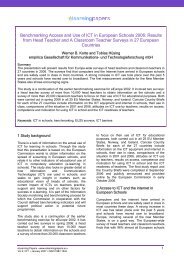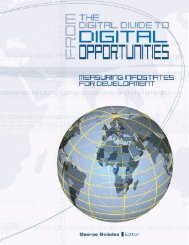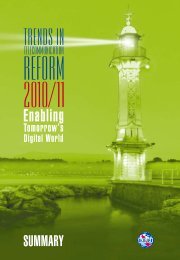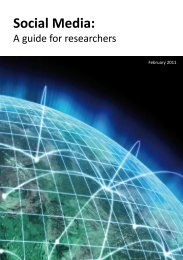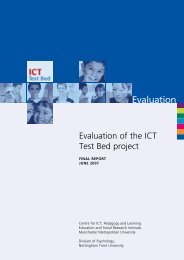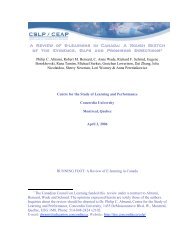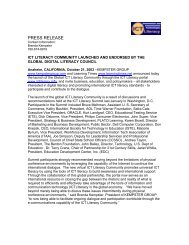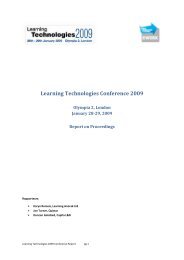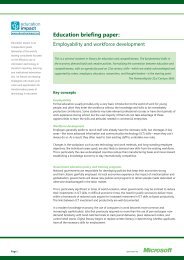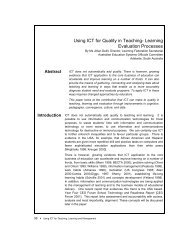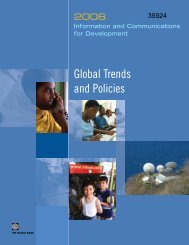The Digital Opportunity Index (DOI) - ITU
The Digital Opportunity Index (DOI) - ITU
The Digital Opportunity Index (DOI) - ITU
You also want an ePaper? Increase the reach of your titles
YUMPU automatically turns print PDFs into web optimized ePapers that Google loves.
connections. 20 In the future, it would be interesting<br />
to include subscriptions to connections capable<br />
of providing broadband access to the household.<br />
This would include not only fixed telephone lines,<br />
but also cable television and suitable equipped<br />
wireless connections, such as third generation<br />
mobile or fixed wireless access.<br />
3.5.2 Getting connected to the Internet<br />
<strong>The</strong> price of computers remains a major obstacle<br />
to wider household penetration, especially in<br />
developing nations. However, one would assume<br />
that, having bought a computer, most households<br />
would then want to connect it to the Internet. In<br />
developed economies, access to the Internet is<br />
more likely to be from home than from the workplace,<br />
with high household Internet and PC penetrations<br />
in all high-<strong>DOI</strong> economies (Figure 3.7, left).<br />
Iceland leads the world, with a household penetration<br />
of Internet access at 84 per cent and PCs at<br />
89 per cent. In many developing countries, home<br />
is not the main place of access for users. <strong>The</strong>re has<br />
been an explosive growth in public Internet facilities<br />
in many countries to cater to those without<br />
home Internet access (see the examples given in<br />
Chapter six). In fact, access from public facilities<br />
may be so successful that it may even be constraining<br />
growth in home Internet access in developing<br />
nations.<br />
However, intriguingly, not all home computers are<br />
connected to the Internet. <strong>The</strong> ratio of home computers<br />
with Internet access differs widely. <strong>The</strong> ratio<br />
of home computers connected to the Internet<br />
ranges from 95 per cent in Estonia to 20 per cent<br />
in Lebanon (Figure 3.7, right). In the Baltic nations,<br />
Estonia and Latvia have computer to Internet<br />
ratios of some 95 per cent, yet in Lithuania, only<br />
50 per cent of computers are connected to the<br />
Internet. Average income in Lithuania is lower<br />
than the other two countries, but Internet tariffs<br />
are cheaper and access is more affordable (See<br />
Data Table 9 in the Statistical Annex). <strong>The</strong>refore, it<br />
is unclear why Lithuania has such a lower ratio of<br />
computers with Internet access. In Latvia, the ratio<br />
was just below 100 per cent in 2005 and exceeded<br />
it in 2006. <strong>The</strong> national statistical office reported<br />
that many households were accessing the Internet<br />
through mobile phones.<br />
Japan has a high proportion of households with<br />
PCs without Internet (Figure 3.7, left) – partly<br />
due to the popularity of mobile Internet access<br />
in Japan. Mobile Internet access could result in<br />
relatively limited functionality in the passive web<br />
experience of cell phones, instead of positive participation<br />
in online web intelligence. <strong>The</strong>se different<br />
patterns of Internet usage could result in<br />
the development of different skill sets and could<br />
shape the Information Society differently, according<br />
to the type, speed and capacity of Internet<br />
access available.<br />
Figure 3.7: Household Internet Access<br />
Household Internet and PC penetration for the<br />
economies with highest household penetrations,<br />
2005<br />
Ratio of household computers with Internet access,<br />
selected economies by region,<br />
2005<br />
% households with Internet % households with PCs<br />
%<br />
Iceland<br />
Denmark<br />
Japan<br />
Sweden<br />
Korea (Rep.)<br />
Netherlands<br />
Taiwan, China<br />
Macao, China<br />
Luxembourg<br />
Switzerland<br />
Singapore<br />
Norway<br />
New Zealand<br />
Hong Kong, China<br />
Germany<br />
Canada<br />
Australia<br />
74<br />
74<br />
75<br />
75<br />
7678<br />
67 70<br />
70<br />
70 7274<br />
818489%<br />
7980<br />
0 100%<br />
100<br />
90<br />
80<br />
70<br />
60<br />
50<br />
40<br />
30<br />
20<br />
10<br />
0<br />
Lebanon<br />
Jordan<br />
Palestine<br />
Paraguay<br />
Mexico<br />
Brazil<br />
Lithuania<br />
Latvia<br />
Estonia<br />
Source: <strong>ITU</strong>/UNCTAD/KADO <strong>Digital</strong> <strong>Opportunity</strong> Platform, adapted from national statistical office data and <strong>ITU</strong><br />
World Telecommunication Indicators Database.<br />
World Information Society Report 2007<br />
49



